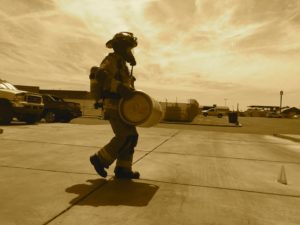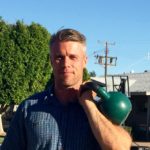Goal #3: Build Strength
Chris Adams

It’s time for another moment of honesty. Firefighting is not a strength sport. It’s endurance. There. I said it. I know this is going to cause contention with a lot of my strength focused firefighting brothers (I say brothers in this case because it seems to be mainly the guys who are obsessed with activities such as “putting up 3 wheels” on the bench.) Look at it this way. Strength when measured in time under tension lasts anywhere from a few seconds to maybe 45 seconds. By definition structural firefighting is not strength. It’s a sustained workload that can last up to 30 minutes.
I posit that what you usually (if you can even say “usually” when talking about emergency operations) see is bouts of high power output (deploying a hose line and searching a room for example) interspersed with lower intensity sustained movement. While I can’t rule out that a moment of maximal strength might be necessary, the loads that we tend to encounter as firefighters are sub-maximal. But sub-maximal is relative to the individual. That’s where a solid foundation of strength is an advantage. It moves the physical demands of firefighting closer to the endurance range.
The stronger you are, generally, the more sub-maximal the loads are relative to your strength. If Jonny ham sandwich can only lift 100 pounds off the floor then dragging his 250 pound buddy out of a building is going to be damn hard. However, if Johnny can lift 350 pounds with solid form, dragging his partner to safety is going to be much easier. So strength does make things easier and does contribute to endurance to a point. More on that point later.
How do you go about improving your strength?
Find a qualified instructor
Notice a trend here? That’s because working with a qualified strength coach will take you farther much quicker than working on your own. A good trainer will offer programming, feedback and an experienced eye that can help you avoid the mistakes of doing it all on your own. I know. I’ve made most of those mistakes. 🙂
Use whole body multi-joint exercises and ditch the body building
You’re not training for a show you’re training for the fight. You probably don’t need curls, tricep kickbacks or three kinds of bench press (although in certain circumstances these kinds of exercise can be useful). Stick with the squats (front, back, overhead, zercher, lunge variations), hinges (deadlift, hex bar deadlift, snatch grip deadlift, clean pulls), pressing (bench press, shoulder press, dips), and pulling (rope climbing, pull ups, bent over row, rotational pulling). Add in olympic lifting if you know how to do it, but realize that it probably isn’t necessary for building a strong foundation. Make these movements the foundation of your training.
Choose consistency over novelty and intensity
True strength training is a long-term process that benefits from patience. Commit yourself to that process. In order to make lasting strength gains you need to spend time with a lift. Choose to improve in small increments gradually over a long time instead of increasing the weight as quickly as possible. You’ll make better gains in the long run. Train with sub-maximal loads frequently and test periodically.
Make your program progressive
Choose a program that increases intensity (weight on the bar or decreasing leverage) over time. Tactical barbell, for instance, is a steady state program that adjusts the weights every 6-12 weeks. Test, train, retest, and repeat at a higher weight.
After building a base, feel free to explore.
The classic barbell lifts are “classic” for a reason. They have a proven track record for making people strong; really strong. However, as you build your base I suggest branching out to increase your movement vocabulary. Explore new movements and variations. Use odd objects, strong man training or your own body weight with gymnastic strength training (GST). Mastering a large volume of movements will help you adapt to any physically demanding situation you might encounter. Surprisingly, once you’ve developed a good base of strength trough progressive training, you don’t lose strength as quickly and some would have you believe.
Honest strength training is something that you can do well into “old” age. It’s established that we tend to lose physical power (the ability to move quickly) as we get older but that strength has the capacity to improve for a long time. In fact, it’s detrimental to aging well and continuing to function without the aid of others. If you’re a person interested in continuing your independence into retirement I suggest you develop and lifelong habit of maintaining and improving your strength.
Suggested strength benchmarks:
• Front Squat 1.0 – 1.5 x body weight.
• Standing shoulder press .75 -1.0 x body weight
• Deadlift 1.5-2.0 x body weight
• Weighted pull up: at least body weight + 70 pounds
• Bench press 1 – 1.5 x body weight
Note: all weights are relative. A lighter individual may need to go beyond what is suggested here while a heavier individual may not need as much relative strength to perform fire operations well. Also note that these numbers represent a base level of strength and are realistic goal to shoot for and maintain. They are pretty modest in terms of weightlifting numbers and I believe provide enough strength to effectively operate as a firefighter.
In conclusion remember that while strength is foundational to fitness, it’s only one aspect of several. Train simply, use the major lifts, and use them consistently until you make significant progress. Save complexity for when a simple program stops working.
Stay tuned to Tactical Barbell for Build Your Engine; part four in a four part series about training for a career in the fire service.
 Chris Adams is a firefighter/paramedic with 15 years of service to the Salt River Fire Department in the Pima-Maricopa Indian Community. When Chris isn’t reading, learning, or blogging about fitness he enjoys rock climbing, canyoneering, and exploring in the American Southwest.
Chris Adams is a firefighter/paramedic with 15 years of service to the Salt River Fire Department in the Pima-Maricopa Indian Community. When Chris isn’t reading, learning, or blogging about fitness he enjoys rock climbing, canyoneering, and exploring in the American Southwest.

Thanks, the strength bench marks are really helpful!
“…an endurance sport” Interesting. Not a firefighter (tactical LE, like swat), but I imagine we carry similar loads in terms of personal gear (probably you guys carry even more). IME the stronger guys have an easier day in terms of avoiding fatigue (brought on by wearing and working in heavy gear) if we’re on our feet at a call. But I guess your baseline strength bench marks take that into account anyway. Anyway, love the articles man!
so, I’m not sure what the tactical kit weighs but our gear is probably around 70ish pounds. That’s not including carrying additional gear if we’re fighting something like a high rise fire. I think you’re right that the stronger firefighters can carry that gear better. Heck, just the bigger people (not necessarily stronger) have it easier because while the stature of the individual can vary greatly the gear’s weight doesn’t change that much.
I wonder though where the balance is. Because more muscle mass, means more oxygen used. And when breathing through an SCBA there is a fixed air supply. So, too big and muscly could mean more air used even at rest. I don’t know.